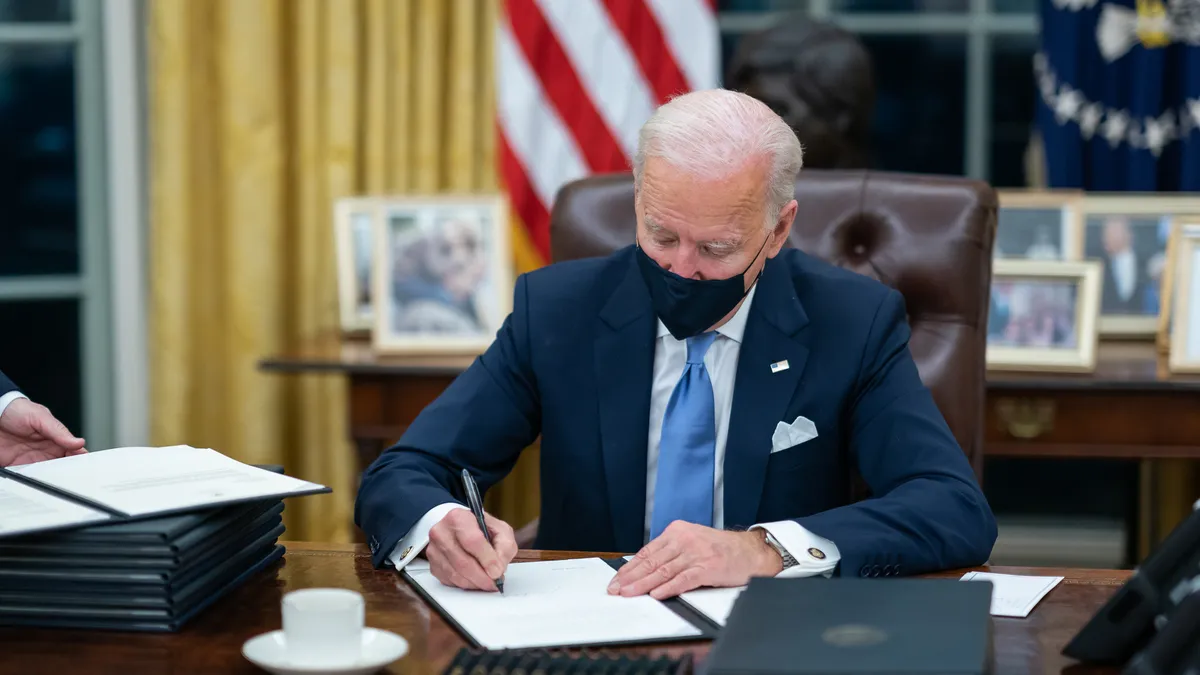Dive Brief:
- President Joe Biden is considering doubling Obama-era decarbonization goals, which would amount to a 50% cut to emissions by 2030, and could announce the economy-wide targets at an upcoming April 22 climate summit with world leaders, Ethan Zindler, head of Americas at BloombergNEF (BNEF), said Tuesday at a virtual energy summit.
- Also on Tuesday, hundreds of businesses and investors published a pair of open letters to Biden, indicating their support for a 50% carbon reduction target. The We Mean Business coalition and Ceres organized and published one letter, and another was published by E2.
- U.S. Secretary of Energy Jennifer Granholm also spoke at the BNEF Summit but did not directly address the chances for a 50% carbon reduction goal. She touted the potential for development of a national clean energy standard, but also said that will require significant negotiations within Congress.
Dive Insight:
The White House has committed to decarbonizing the United States economy, but just how that will happen remains to be worked out, said Granholm.
"I think there are still versions of a clean energy standard that work for Senate reconciliation rules," she said, referring to Democrats' ability to pass legislation with just 51 votes.
However, Zindler noted during the discussion that it remains an "open question" as to whether this can technically be done with the standard, which could direct utilities to deliver increasing amounts of carbon-free electricity.
"I think that's an opportunity," said Granholm. "This administration is committed to doing a clean energy standard."
White House climate adviser Gina McCarthy has previously indicated the White House is considering a standard to boost renewables, and that it could also include nuclear and carbon capture technologies.
Granholm also floated the idea of developing a series of incentives for states that would essentially add up to a national standard. Ultimately, "no decisions have been made on exactly how it will work," she said.
Goals the White House has announced, including 100% clean electricity by 2035 and economy-wide zero carbon emissions by 2050, "have everybody pointing in the same direction, and that includes departments that are not related to clean energy at all," she said.
The American Jobs Plan laid out a "framework of what things should look like," but everything remains "subject to negotiation in Congress," said Granholm. The White House published the plan in March, sketching out a list of priorities for Congress to develop into an infrastructure package. That process is now ongoing.
There is some money allocated in the budget for DOE to help oversee a potential clean energy standard, but how that works "depends on how it is crafted," Granholm said.
The United States previously pledged a 26-28% cut of economy-wide emissions by 2025, below a 2006 baseline, and the Clean Power Plan developed under Obama was intended to help reach those targets. But the law was ultimately stayed by the U.S. Supreme Court, and President Donald Trump subsequently withdrew the United States from the Paris climate accord. Biden has since rejoined the accord, reestablishing that emissions reduction goal.
Granholm said U.S. decarbonization commitments are an essential model for the rest of the world, especially ahead of the 2021 United Nations Climate Change Conference in Glasgow, where Special Presidential Envoy for Climate John Kerry will represent the U.S.
"We can't get on our moral high ground when we have not been able to do what we're asking others to do," Granholm said. The United States needs to be able to go to Glasgow in November and say "look at the commitments we have made."
"We want people to be announcing their interim goals and finalizing them by the time they get to Glasgow," Granholm said. "And we have to do what we need to do as a country as well, in order to be able to have any credibility on the national stage."
As of now, the United States has actually cut emissions 20% below the 2005 baseline said Zindler. That leaves the country in good shape, but those reductions are at least partly due to the global pandemic and resulting economic slowdown. With the economy rebounding, emissions could rise also, he said.
The United States added 35 GW of new wind and solar in 2020, said Zindler, more than doubling the previous high of 17 GW. Some of that was due to a frontloading of projects over concerns about tax credit expirations, "but nonetheless we think we may have stepped up to a new plateau in terms of average build."
BNEF now expects a sustained 30-40 GW of new annual renewables build, out to 2030, said Zindler. But it will not be enough to meet zero-carbon targets, and he said new energy policies are needed to accelerate the growth of green power.
"If you want to truly decarbonize the power sector ... you really need to double the amount of wind and solar you're building on an annual basis, to get to some kind of 0% goal by 2035," he said. "You're going to need a lot more build than we've seen to date."
Adding renewables and cutting carbon 50% by 2030 appears to have some support within the business community. Tuesday letters from business leaders warned the United States is falling behind global competitors due to a lack of focus on clean energy.
"A target of at least 50% below 2005 levels by 2030 will send that signal and provide the private and public sectors with the focus needed as we rebuild our economy from the ravages of climate change and the pandemic," 388 businesses and investors said in the E2 letter.
The We Mean Business/Ceres letter was signed by 310 businesses and investors, and says the U.S. must adopt a 50% by 2030 target "to restore the standing of the U.S. as a global leader." Apple, General Electric, Edison International, Facebook, Verizon and Walmart were among those who signed.














